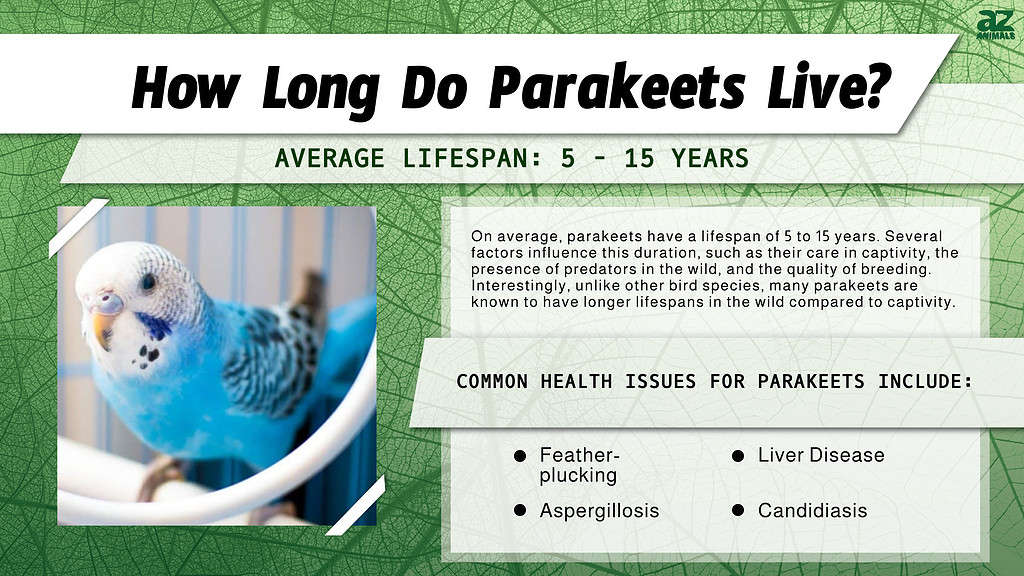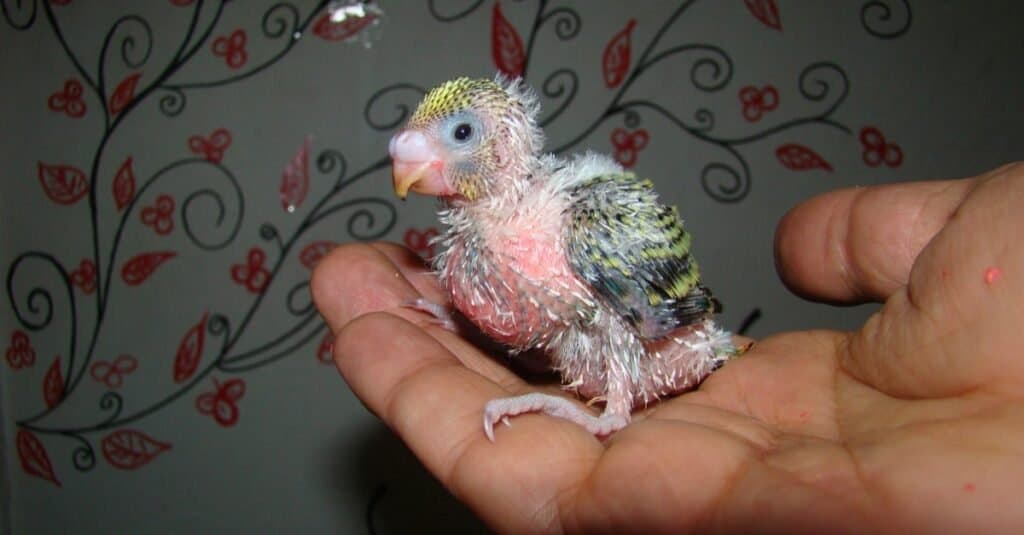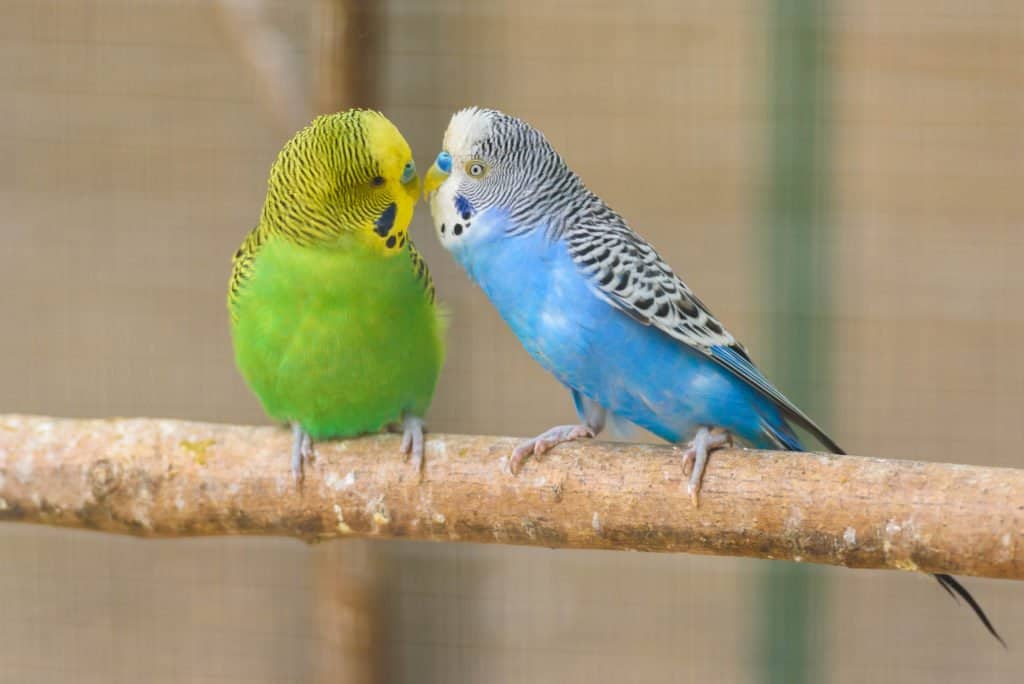
One of the most popular pet birds that you could own, the parakeet is a surprising pet when it comes to how long it lives. How long do parakeets live exactly? There are many factors that affect this answer.
Small, smart, and adorable, parakeets are beloved around the world. In this article, we will discuss how long exactly parakeets live both in the wild and in captivity, as well as what their standard life cycle is like. How long do parakeets live? Continue reading to find out.

The chirp of a parakeet is compared to background noise.
©iStock.com/averess
How Long Do Parakeets Live?
Parakeets live for 5 to 15 years on average. Many factors affect this number, including their overall care in captivity, potential predators in the wild, and quality of breeding. Many parakeets are known to live longer in the wild than in captivity, which is not common for other bird species.
For example, the average wild parakeet can live well beyond 10 years, and can sometimes live over two decades. While most animals tend to live longer in captivity, parakeets are often treated unfairly or are victims of inappropriate breeding from pet stores and pet suppliers.
It is important to find a reputable parakeet breeder if you are considering bringing one of these birds into your home. Many parakeets are inbred or otherwise not cared for properly, which is why they live longer lives in the wild.
When properly cared for, parakeets can reach much longer ages than their typical lifespan. In fact, one parakeet named Charlie was the oldest parakeet on record and lived to be 29 years old. By choosing a parakeet from a reputable breeder and giving it good care, its like your parakeet can reach beyond the average lifespan in captivity.
Either way, both pet and wild parakeets have the same life cycle. Let’s discuss this now.

©iStock.com/Werner Baumgarten
The Average Parakeet Life Cycle
Curious to know what a parakeet goes through, from the moment it hatches until old age? Let’s learn about these birds now!
Hatchlings
Parakeets are unique in that they lay multiple eggs at once, but only one egg hatches at a time. This leads to multiple sizes of baby parakeets in a nest, and mother parakeets know instinctively to feed the freshly hatched birds first. This leads to a wild parakeet’s chances of high survival.
Hatchlings are born naked and without the use of their senses. They are fed milk from their mother and are able to see after 7 to 10 days. After about a month from the day they hatch, baby parakeets will begin to grow their feathers and look more like the birds they are meant to be.
Young Parakeets

Hatchlings are born naked and without the use of their senses.
©Dr.MYM/Shutterstock.com
Young parakeets are capable of fending for themselves and living without the help of their parents once they are 3 to 6 months old. However, parakeet families tend to stick together, and young parakeets still rely on their parents for socialization until they are a year old.
Young parakeets should be socialized frequently, especially if they are going to be raised as pets. Most breeds of birds enjoy a large level of socialization among their own kind, and parakeets are no exception. It is beneficial to their mental health to have other birds to socialize with.
Adult Parakeets
Parakeets are considered adults when they have reached a year of age, as this means they are ready to breed. They should be fully grown and a few inches in length, covered in brightly colored feathers and patterns.
Even adult parakeets need frequent socialization, especially among their own kind. This can be difficult to accomplish if you own a parakeet as a pet, and it may be why wild parakeets thrive despite the presence of predators.
Parakeets grow up with their parents and learn many different behaviors from them. Some of these behaviors include grooming, beak rubbing and kissing, and general modes of playing. Parakeets are very sociable and talkative, with or without their own kind with them.
If you own a pet parakeet, you may be wondering how you can best care for it with or without other parakeets to socialize with. Let’s talk about how you can give your parakeets the best life possible.
How to Extend the Life of Your Pet Parakeet

Adult parakeets need socialization, especially among their own kind.
©Uliya Krakos/Shutterstock.com
Your parakeet is as much a part of your family as any other pet and needs just as much stimulation and socialization. Let’s talk about how you can extend the life of your pet parakeet in the following ways:
- Watch out for signs of stress. Pet parakeets are small and potentially nervous pets. They are not shy about how they feel, however. They often exhibit signs of stress and nervous energy through their chatter, behavior, and eating habits. It is important to pay attention when your pet parakeet is stressed because this can have an overall effect on its lifespan. Pay attention to how chaotic your household is, and if your parakeet is being kept in a high-traffic or temperature variable area.
- Consider two parakeets instead of one. Parakeets are extremely social, based on their life cycle and the amount of time that they spend with their parents and siblings. This is why it can feel necessary to adopt two parakeets instead of just one. They crave the company of other birds and often feel safer when they aren’t alone. Parakeets are more likely to live a long and happy life if they have a sibling or parakeet friend to spend time with. A single parakeet will still thrive in a home, but it is more likely to become bored, depressed, and aggravated.
- Feed them a variety of things. Parakeets are very active and therefore require a high level of nutrition. Not only do they need high-quality bird seed, but they should also be fed fruits and vegetables as well. Make sure not to give them anything toxic, so do your research before feeding your new friends. However, a wide variety of foods are good for them and safe for them to eat.
The photo featured at the top of this post is © Uliya Krakos/Shutterstock.com
Thank you for reading! Have some feedback for us? Contact the AZ Animals editorial team.






